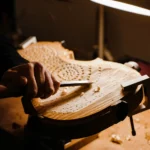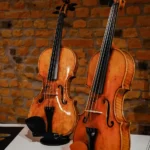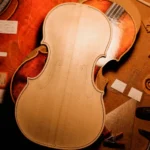Italian Violin Making Techniques: Inside The Workshop
Back to BlogThe Legacy of Italian Violin Making
Italian violin-making has a captivating history that resonates deeply within the music world. Renowned Cremonese luthiers like Stradivari, Guarneri, and Amati stand as pillars of this legacy; their musical instruments played unforgettable melodies in the minds of musicians and enthusiasts alike through centuries until nowadays. Rooted in craftsmanship and finesse, this tradition has left an enduring impact on the musical landscape.
The Italian violin’s allure lies in its historical significance and the tangible connection it offers to musicians and audiences. Each note played carries the essence of centuries-old techniques and the unwavering commitment of those who have crafted it. This legacy, still alive and vibrant, continues to enrich the world of music, inviting us all to appreciate the harmonious marriage of craftsmanship and melody.
Central to this legacy is Cremona, Italy—a city steeped in the art of violin crafting. Here, the evolution of techniques and meticulous attention to detail have shaped string instruments that transcend time. In the heart of workshops, luthiers have woven together a blend of skill, passion, and dedication to produce instruments that capture the essence of musical expression.
Craftsmanship and Artistry in Violin Making
Italian violin makers have long been renowned for crafting musical instruments that transcend functional utility. Each violin, viola, and cello that emerges from their workshops carries the mark of a masterful creator, blending woodworking disciplines with the spirit of artistic expression. These string instruments are not only tools for creating music but also works of art that resonate with the emotions of the player and the audience.
At the heart of this craftsmanship lies the choice of materials—a critical element in shaping the tonal character of Italian string instruments. Selecting high-quality woods, varnishes, and fittings is a carefully considered process, with each component contributing to the final sonic signature. The result is a harmonious synergy between material and sound, where the wood’s resonance harmonizes with the melodies drawn from the strings. In Italian violin making, the dance between craftsmanship and artistry yields instruments that are a testament to human creativity and the enduring power of music.
The Pioneers of Italian Violin Craftsmanship
In the world of Italian violin crafting, specific names stand tall, shaping the course of history. Among them are Antonio Stradivari and Guarneri del Gesù, revered for their exceptional contributions. These artisans weren’t just skilled makers but pioneers who left an indelible mark on the craft.
Antonio Stradivari brought innovation and finesse to the forefront. His careful experimentation with materials and techniques led to the creation of violins celebrated for their extraordinary sound. Guarneri del Gesù, a contemporary of Stradivari, embraced a bolder style, infusing his instruments with distinctive character.
And let’s not overlook the Cremonese luthier Andrea Amati, the trailblazer who laid the foundation for Italian violin making. His methods paved the way for future artisans to refine and build upon. These masters, each with their unique approach, collectively shaped the art of violin-making we know today. Their impact isn’t confined to their era; it reverberates in every note played on their musical instruments, a testament to their enduring legacy.
Techniques Passed Down Through Generations
In the world of Italian violin making, mastery isn’t just acquired; it’s passed down through generations, shaping a legacy of expertise. This tradition thrives on the art of mentorship, where experienced craftsmen share their wisdom with a new wave of makers.
The importance of skilled assistants and apprentices cannot be overstated. These dedicated individuals served as technique custodians, learning under seasoned artisans’ guidance. Their role was pivotal in refining and preserving methods that had been honed over centuries.
As time flowed, techniques evolved. The Baroque era and baroque instruments witnessed the birth of methods that would form the foundation of violin making. Fast-forward to modern times, and contemporary Italian violin makers continue to breathe life into these traditions.
The Workshop of Italian Violin Makers
The workshop of an Italian violin maker is a place where skill, passion, and tradition converge. Here, the magic of creating exceptional musical instruments unfolds, guided by a deep-rooted commitment to craftsmanship.
Crafting each violin, viola, and cello is a meticulous journey. It starts with the selection of high-quality materials—woods that will resonate with the character. The luthier carves and shapes with a discerning eye, paying utmost attention to every curve and contour. It’s a process that marries precision with intuition as the maker brings out the instrument’s unique voice.
Assembling the various components is akin to orchestrating a symphony. Each piece is carefully positioned and secured from the spruce top to the maple back. The soundpost and bass bar are meticulously placed, ensuring the harmonious transfer of vibrations. The application of varnish, the violin’s protective coat, is a deliberate act that enhances both aesthetics and sound quality.
The Classic Italian Violin Sound
The tonal qualities of Italian violins are a symphony of warmth, clarity, and projection. These musical instruments possess a distinct character that captivates the ears of musicians and listeners alike.
The hallmark “classic Italian sound” isn’t just a coincidence; it’s the result of a meticulous marriage between craftsmanship and wood selection. Italian violin makers have perfected the art of using specific woods to coax out the desired tonal nuances. The spruce and maple chosen for each instrument play a pivotal role in shaping the resonance, enabling the instrument to sing with clarity and depth.
The result? When an Italian violin is played, its sound carries a distinctive warmth that envelops the room. The notes possess an unparalleled clarity, allowing even the most delicate nuances of a piece to shine through. Moreover, the projection—the instrument’s ability to fill a space with its sound—seamlessly intertwines with the artist’s expression, creating a harmonious dialogue between the player and the instrument.
A Harmonious Tradition
Italian violin making isn’t just a craft; it’s an unfolding legacy that thrives on mentorship and innovation. From the past to the present, the artistry of these musical instruments continues to resonate through the hands of musicians, carrying the essence of Italy’s musical heritage. Through dedication, passion, and expertise, contemporary Italian violin makers create violins that aren’t just tools for music but gateways to a world of expression and emotion.
Explore Italian Violins
Ready to immerse yourself in the world of Italian violin craftsmanship? Explore our exquisite collection of fine Italian and contemporary Italian violins, violas, and cellos. Our Italian violin makers listed have won several international violin-making competitions, and each instrument carries the echoes of history, a testament to the artistry that has shaped the musical landscape for centuries.









